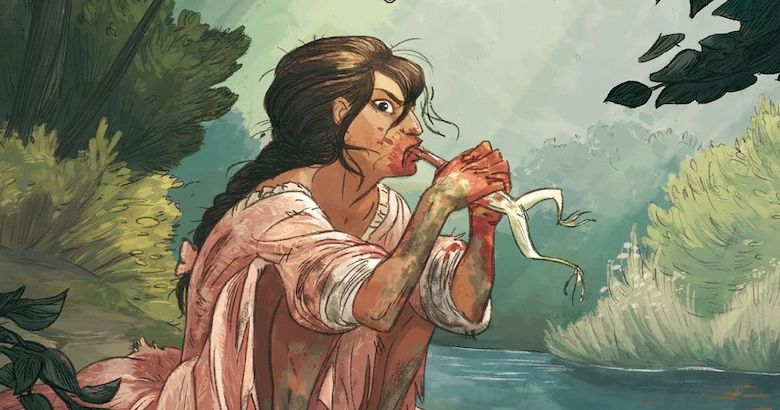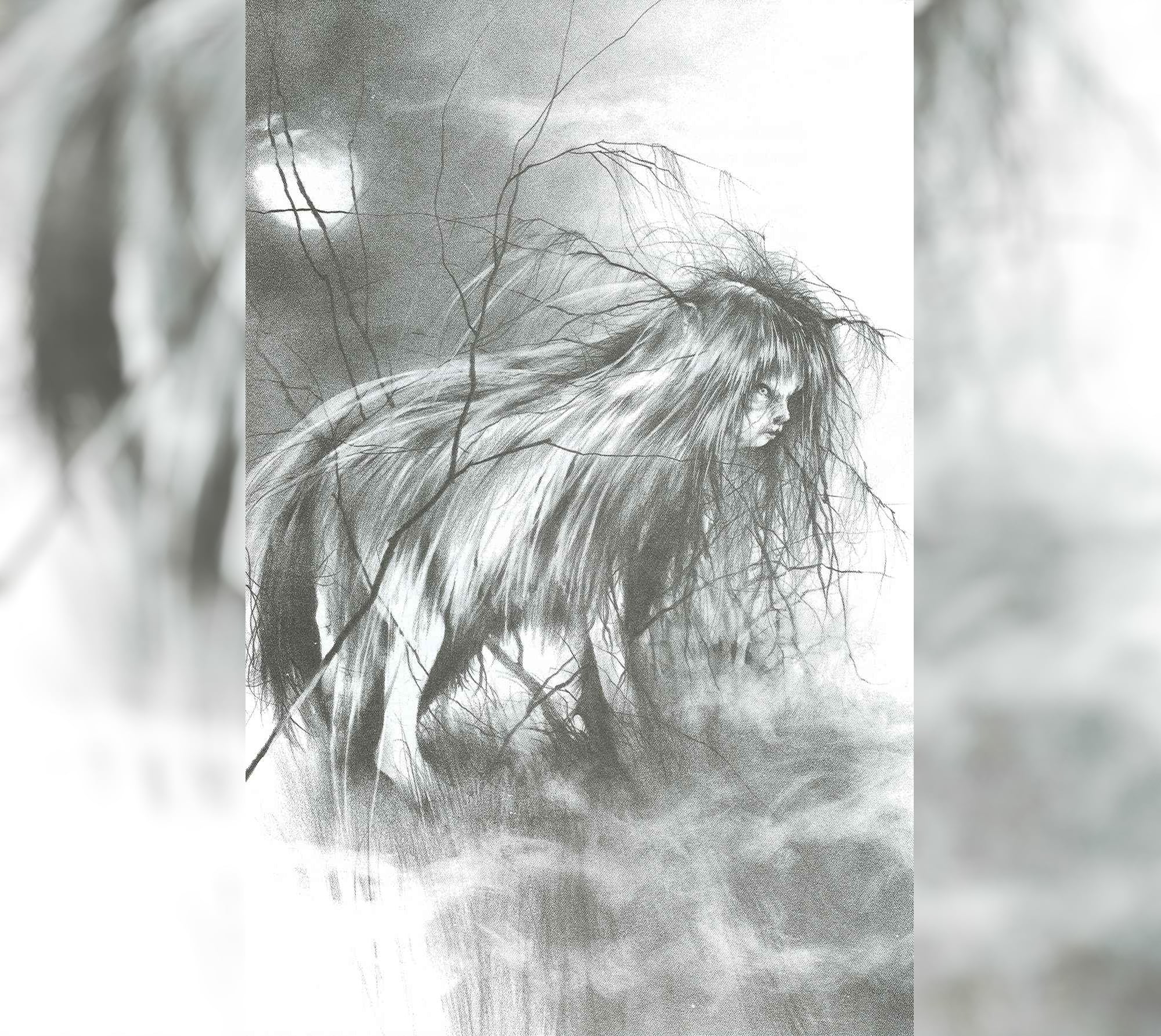I made a documentary about Scary Stories to Tell in the Dark. (Now available to watch.) The three books consisted of over 80 stories of folklore and urban legends. It was impossible to appropriately address each and every story in a single documentary. This website, in part, is a chance to look at individual stories that I researched, tales in which I learned about their origins and social contexts. It’s a chance to examine stories that I ultimately found to be fascinating in some way or another.
This is Wolf Girl.
Stories of “feral children” are littered all over folklore of many traditions. Alvin Schwartz adapted a particular tale of one such story in Scary Stories to Tell in the Dark‘s “Wolf Girl.”
There is something foundational in just about every culture that returns to this idea. It is entrenched with post-colonialist fears and deep, natural suspicions of native inhabitants of any region that Europeans have migrated to in history. The fear of this new natural world engulfing one of their own and making them feral and too animalistic is engrained in people’s psyche.
But also, it actually happens. There are many actual incidences, which only feeds the storytelling engine of the folklore of different regions.
Let’s dive into this particular example of such stories.
The Story of Wolf Girl
Alvin Schwartz made sure to mention famous examples in storytelling like Mowgli in Rudyard Kipling’s The Jungle Book and other American folk examples in the Ozarks of Arkansas and elsewhere.
Examining the topic of feral children will result in many more examples, including many real feral children that have been documented such as Marcos Rodríguez Pantoja and Marie-Angélique Memmie Le Blanc.

Here is the version that can be found in Scary Stories to Tell in the Dark, Wolf Girl.
Travel northwest into the desert from Del Rio, Texas, and eventually you will come to Devil’s River. In the 1830’s, a trapper named John Dent and his wife, Molly settled where Dry Creek runs into Devil’s River. Dent was after beaver, which were plentiful there. He and Molly built a cabin from brush, and near it, they put up an arbor to give them shade. Molly Dent became pregnant. When she was ready to have their child, John Dent raced on horseback to their nearest neighbors several miles away. “My wife is having a baby,” he said to the man and his wife. “Can you help us?” They agreed to come at once.
As they got ready to leave, a violent storm came up, and a bolt of lightning struck and killed John Dent. The man and his wife managed to find his cabin, but did not arrived until the next day. By then, Molly Dent was dead too. It looked as if she had given birth before she died. But the neighbors could not find the baby. Since there were wolf tracks all around, they decided the wolves have eaten it. They buried Molly Dent and left.
A number of years after she died, people began to tell a strange tale. Some swore it was a true story, others said it never could have happened. The story begins in a small settlement a dozen miles from Molly Dent’s grave. Early one morning, a pack of wolves raced in from the desert and killed some goats. Such attacks were not unusual in those days. But a boy thought he saw a naked young girl with long blonde hair, running with the wolves. A year or two later, a woman came upon some wolves eating a goat they had just killed. Eating the goat with them, she claimed, was a naked young girl with long blonde hair. When the wolves and the girl saw her, they fled. The woman said that at first, the girl ran on all fours, then she stood and ran like a human, swiftly as the wolves. People started wondering if this wolf girl was Molly Dent’s daughter. Had a mother wolf carried her off the day she was born, and raised her with her pups? If so, by now she would be ten or eleven years old.
Origin of Scary Stories to Tell in the Dark‘s Wolf Girl
Alvin Schwartz in Scary Stories to Tell in the Dark’s “Wolf Girl” credits two particular versions for being his main inspiration. One is an oral tale told to him by someone during his travels, and the other is a story “The Lobo Girl of Devil’s River” from L.D. Bertellion.
One version of Bertellion’s tale of the “Logo girl” can be found in a book Straight Texas by Frank J. Dobie (1966), found here. Below is the same story told slightly differently, since there are numerous versions as it was told orally for so many years.
In the fall of 1830, John Dent and Will Marlowe teamed up to catch fur beasts along the source of the Chikamauga River in Georgia. The two worked very well together until the spring of 1833, when they lost their winter catch.
The cause of the quarrel was a woman named Molly Pertur, whose father was a mountaineer. While hunting animals in the vicinity of Pertur’s hut, Dent fell in love with her, and the two made a lifelong agreement. In partnership, the two orcs agreed to jointly sell all the skins they were carrying, for an average penny. They enforced the agreement for the first two seasons; but now Dent insisted on taking half of the skin sheet and leaving it at his disposal. He had the idea that if he sold his skin alone, he would be able to earn more money to spend on his marriage expenses.
After a fierce quarrel, the things were evenly divided according to Dent’s request. Almost as soon as Marlowe finished, he told others that he had been deceived. The argument lasted 2 weeks, and then there was a fight, and Dent stabbed Marlowe to death. Public opinion opposed him, and he had no choice but to go away. Before leaving, he managed to meet his lover and tell her that he was going to find a place where they could live together. He also said he would come back and secretly pick her up.
As the months passed, people gradually lost interest in the matter. During this time, Molly Pertur may not have heard from the murderer’s lover. Then on April 13, 1834, shortly after the sun set in the west (exactly the year after Marlowe was killed), Morley went to the cattle farm to milk the cows, which was her habit. She had been away from home for an unusually long time, and her parents decided to investigate to see if something had happened. They found that the cow had not been milked, and they also saw a long knife in the empty milk bucket, with dry blood clotted on the handle, and the handle was made of antlers and strangely designed. The next day, people recognized at a glance that it was dent who killed Marlowe’s knife.
What is interesting is that this story of a feral child in both Bertellion’s Lobo Girl and Scary Stories to Tell in the Dark’s Wolf Girl mix feral children and “cryptid tales” reminiscent of Bigfoot or the Chupacabra.
— FOUNDATIONS OF HORROR —
Further explore these subgenres & tropes. more>>
#Scary Stories to Tell in the Dark | #Cannibal horror | #Folk horror | #Monster horror | #Foreign Locations are Scary | #Natural horror

In all these stories, there are real-world explanations. Seeing from a distance a bear walking upright for the first time could result in an early European to tell tales of a big-footed hairy beast (a Bigfoot). Seeing from a distance a man riding a horse for the first time could result in tales of a minotaur or centaur, half-man half-horse. Seeing an unusual wild dog for the first time could result in tales of a Chupacabra. And so yes, seeing a Native American wearing what they deemed unusual clothes such as animal fur, perhaps of a Native tribe they had not seen before, evolves into something like the Wolf Girl story.
The fact that these stories come from Mexican land may mean something. While the Spanish had encountered Native Mexican customs for centuries, it is easy to imagine that expansion of Northeastern American travelers into the lands would result in them seeing customs that they were otherwise not familiar with in seeing other Native tribes of their lands. It also can very well mix with native Mexican animals that American travelers were not accustomed to. Similar to someone accustomed to the Mexican desert traveling north and seeing a bear walking upright for the first time. That is where unusual folk tales begin, and thus easily where something like Scary Stories to Tell in the Dark‘s Wolf Girl finds its origin.
Last Updated on November 3, 2022.

